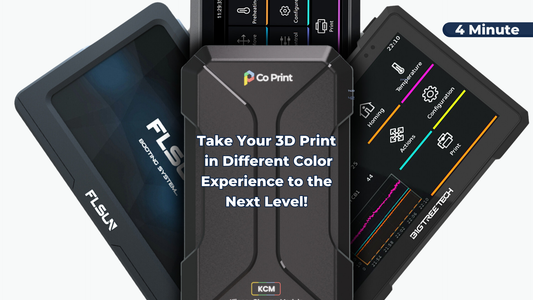3D printers work like magic to transform the digital world into tangible objects. The basic building blocks of this magical world are plastic wires called filaments. Filaments produced from different materials and properties help you fully unlock the potential of your 3D printer.
In this comprehensive guide, you'll find everything you need to know about 3D printer filaments and more:
Filament Types:
-
ABS: It is one of the most popular filaments due to its durability, flexibility and affordable price. Ideal for automotive parts, prototypes, durable objects and robotic parts.

-
PLA: Made from bio-based sources such as corn starch, PLA is more environmentally friendly than ABS. It stands out with its easy printing, low-odor production and wide color range. Perfect for figures, toys, home decoration and food contact objects.

-
PETG: Combining the best features of ABS and PLA, PETG stands out with its ability to be water-resistant, transparent and resistant to high temperatures. Ideal for waterproof containers, bottles, food contact objects, parts exposed to chemicals and outdoor applications.

-
TPU: With its flexibility at the forefront, TPU is an excellent choice for phone cases, cable protection, wearable technology products, sports equipment and medical models.

-
PVA: PVA, a water-soluble filament, is used as support material. Ideal for creating easily removable supports for objects with complex geometry.

-
PC: Ideal for applications requiring high strength, heat resistance and chemical resistance, PC also attracts attention with its transparent and translucent options. It can be used for engineering parts, electronic enclosures, lighting fixtures and food contact objects.

-
Nylon: Ideal for applications requiring strength, durability and high abrasion resistance, Nylon also offers flexibility and chemical resistance. It can be used for machine parts, gears, bearings, sports equipment and textile products.

-
Wood: Wood filament, which gives the appearance and texture of wood, is ideal for producing aesthetically striking objects. It can be used for decorative objects, figures, toys and architectural models.

-
Metal: Metal filament, which gives a metal appearance and texture, is ideal for producing original and eye-catching objects. It can be used for sculptures, figures, decorative objects and jewelry design.

Filament Properties:

-
Printing: Filaments are produced in different diameters such as 1.75 mm, 2.85 mm and 3 mm. It is important to choose a filament that is compatible with the filament diameter of your printer.
-
Color: Filaments with a rich color range allow you to print objects in the colors you want without limiting your imagination. In addition to standard colors, fluorescent, metallic, transparent and wood-look filaments are also available.
-
Heat: Each type of filament has a different melting and printing temperature. You need to adjust your printer's settings according to the temperature range of the filament.
-
Filling Ratio: The fill ratio, which determines the amount of filament used during printing, affects the strength of the object, its weight and printing time.
-
Print Speed: Different filament types are suitable for different printing speeds. Higher print speed allows for faster production but may affect print quality.
-
Flexibility: Flexible filaments are ideal for producing objects that are resistant to impact and vibration.
-
Water Resistance: Water-resistant filaments are ideal for outdoor applications and food contact objects.
Filament Selection:

When choosing filament you need to consider the following:
Filament Storage:

Storing filaments in airtight containers in a cool, dry place is important. Filaments that can be affected by moisture can reduce print quality if not stored correctly. It is also important to keep the filaments away from sunlight.
Interesting Details About 3D Printer Filaments:

We hope this comprehensive guide will help you learn more about 3D printer filaments and make the right filament choice.
If you have questions or comments about 3D printer filaments, feel free to write below.
You can also specify the brand and model of your printer for specific filament recommendations for your 3D printer.
We wish you pleasant printing with your 3D printer!

 Store
Store



